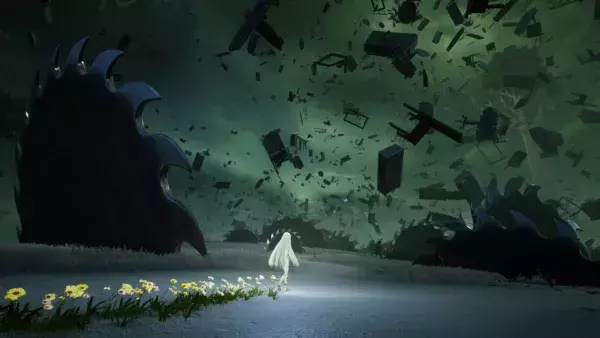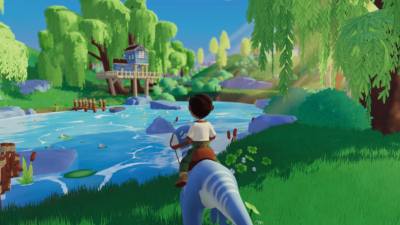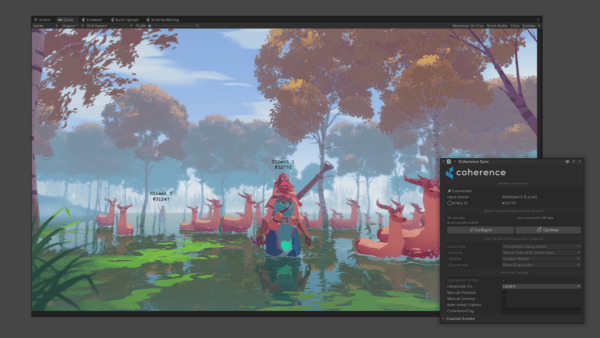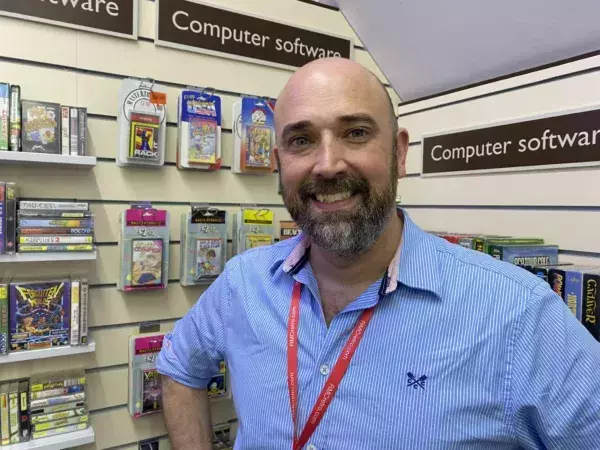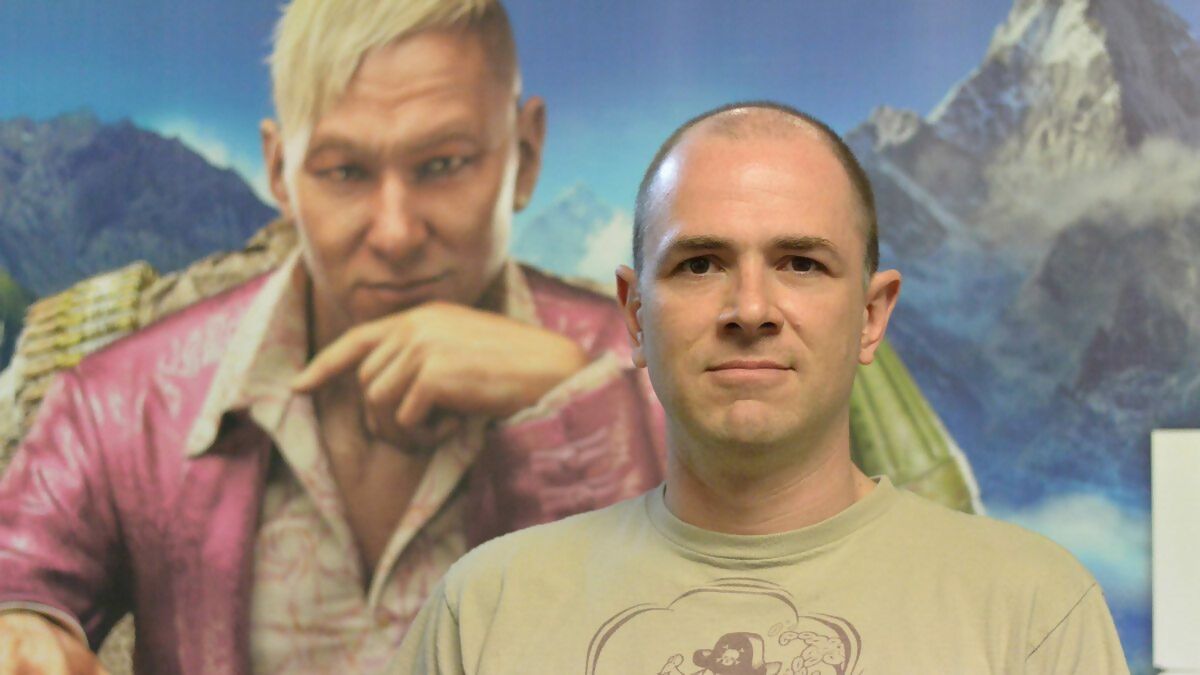
To an indie developer used to working with one or two collaborators, a studio of 25 people probably sounds huge. But for Alex Hutchinson, co-founder of the brand new Typhoon Studios in Montreal, it’s positively tiny; the director of such games as Assassin’s Creed III and Far Cry 4, Hutchinson has spent the last eight years of his career dealing with the pressures of mega-budget titles and vast armies of artists and coders. In his previous role as creative director at Ubisoft Montreal, he was at the helm of a company with as many as 3500 employees.
With Typhoon Studios, however, Hutchinson’s taking a step back from the expensive sequels and marketing hype. With his co-founder Yassine Riahi and a hand-picked group of designers, he’s now at the helm of a game that, he says, “is halfway between an indie and a triple-A”. The only trouble is that when we settled down with Hutchinson for a lively interview over Skype one autumn afternoon, the specifics of Typhoon’s debut game had to remain firmly under wraps.
Nevertheless, Hutchinson still gives us a flavour of what to expect: loud, brash, and with a focus on unscripted events and exploration. Hutchinson is candid, too, about the pressures and minor absurdities of developing huge franchise games, and how his start as a young hopeful from Australia led to a successful career in the United States.
Going right back to early in your career, you had a degree in archaeology. So did you always think you’d go into game development?
Um, I did not. I always thought it would be impossible. I grew up in Melbourne, Australia, and I grew up on Amiga Power, my Amiga 500, and early Nintendo stuff. Things that were occurring in London or Tokyo didn’t seem very realistic from where I was, aged ten. So I did some stuff I was interested in – I did a lot of writing when I was younger. I got a degree in archaeology. But I didn’t think I could get in – it was only when games started to get bigger and the roles started to become more specialised. Studios would hire specialised designers who couldn’t code, or hire writers who couldn’t code. Those opportunities opened up, and I was able to get in pretty early with that first explosion.
I’ve a great fondness for the more unusual videogame magazines. I remember buying many magazines back in the day and typing 4000 lines of code, trying to get them to compile and load. The first work I actually did in the games business, was I wrote a Sensible Soccer guide for Amiga Action back in the very early 90s. So I’ve a fondness for the British side of the games magazine industry.
I was a designer for a small studio called Torus Games in Australia, many moons ago. I worked on a lot of Game Boy games for Activision, basically. After which I went to Maxis in California, where I was the lead designer on The Sims 2 and Spore, then up here to Canada, where I did Army of Two: The 40th Day for EA, and then Assassin’s Creed III and Far Cry 4 for Ubisoft. Then we hit that mid-life point where we had to either go out on our own or admit that we were always going to be work-for-hire creators. So we chose to start our own studio.
We started Typhoon in February last year, which has been a rollercoaster. In that time we’ve gone to about 25 people. We’ve signed with our publisher, 505 Games, after a year of prototyping and experimenting and putting carpet down in a building, all that exciting stuff. We’re looking to announce our first game hopefully this year, maybe early next year.
You ascended the ranks through the games industry really quickly. So what’s the key to that? What skills do you need to have as a lead designer and a director?
I think I was lucky in a sense that when you get in early, you have a chance to learn. And even though I didn’t get on big projects early on – I was put on Game Boy games – they were very short-schedule. So they were six weeks to sixteen weeks from the phone ringing in Activision saying, “Can you do an Iron Man game on Game Boy” to us actually shipping the finished build to them. So you learn the ropes of pitching and being tight on your design, and finishing it in a short schedule. That was very, very useful. And then when I got in, I was 22, 23, you’re not married, you don’t have kids, you’re willing to move around the world, so being very flexible. I worked a lot of hours, I was always first in, last out. I tried to learn as fast as I could.
I didn’t do a lot else for a long time!

Army of 2: The 40th Day – Hutchinson’s directorial debut.
You said you’re not an artist or coder, so how does the seed of a game get planted for you? Is it through writing that you get ideas for your games?
Yeah, it is. It’s through writing, and I tend to do a narrative sales pitch: imagine if you’re in this situation, and imagine if you’re in this world, and imagine if you were able to do these things. That’s the core for me. You can tell when you’re pitching to people and their eyes light up, or if they look at you and they say it’s terrible, I wouldn’t play that. You get some early feedback. Then the rest is, I like drawing big charts of mechanics – what are the ins for the players, what do the buttons actually do for them, and how does that affect the world in sort of a flow-chart fashion, to see if there’s a big, expansive, flexible place for the player to play around in.
What was it like to graduate to Army of 2? Was that a big step to take?
It was a bit scary. I’d been chatting to Ubisoft, and I had an office for a game that would’ve been bigger budget and more visible. But I felt that I wanted to get it right. It seemed like the right scale of project, I had friends on that team, and I just liked that idea. Not so much the tone, which we tried to fix, but in terms of you and your best friend versus the world, I really liked the emotional hook of that, and I think that’s why those first two Army Of 2 games were so successful, because you had you and your best friend or your partner against anything the game could throw at you.
What are the practicalities of starting a studio from scratch? You mentioned choosing the carpet and all that kind of stuff, but what else did you have to consider?
We’re in the process of discovering new things we have to take seriously. We obviously knew hiring was going to be a big focus when you begin finding the right people – getting the right team together is the most important thing, in my opinion, of any game, other than having a decent idea. We were fortunate enough to find a good partner early on in Makers Fund, who are a Chinese investment company. They took a stake in the business while we built ourselves up and looked for a publisher. That gave us the time to develop and partner with 505 Games.
 15_of_19_.jpg” alt=”” width=”1920″ height=”1080″ />
15_of_19_.jpg” alt=”” width=”1920″ height=”1080″ />Expect Far Cry 4’s emergent gameplay elements to figure in Typhoon’s untitled new game.
I read that at Ubisoft Montreal you had 2500 people working there. So did it feel that you had to step back from that size of business as well?
Yes, for sure. I think Ubisoft Montreal is 3500 people these days – it’s a monstrous studio, in three buildings down here in Montreal. It’s a fabulous place, and I loved my many years there, but it can become impersonal and very large. It’s very hard to sneak in those little individual touches and personal flourishes that you might want to put into a game that a small group of people can completely own. So that was one of the big attractions of starting Typhoon – the idea that we could take something from an idea to finish and keep it a little bit esoteric and a little bit unusual, and give it a flavour that would be too strong to push through in a triple-A release.
Is there a significance behind the name, Typhoon? Is it a cool-sounding word or is it a hint at the type of games you’re going to make?
Hopefully it’s a bit of both. It’s almost impossible to find a name that somebody else doesn’t already have, and that’s short enough and punchy enough that people will remember it. So we ended up with the idea that it was a simple word that is basically the same in French and English, which is important here in Montreal. It’s short and punchy, and we always liked the idea that we’ll make games that are strong‑flavoured. There are a lot of companies out there that feel to me like music in the 1950s in a sense – everyone’s on the same show wearing the same suit, you know? I think that there’s enough room in people’s personal tastes to enable all kinds of games.
We think that it’s OK if not everyone loves your game. It’s OK to have people hate it, as long as you have a core that does actually love it. We want to be polarising. We think the opposite of love is indifference.
 1_of_19_.jpg” alt=”” width=”1920″ height=”1080″ />
1_of_19_.jpg” alt=”” width=”1920″ height=”1080″ />The 25-strong Typhoon team, outside their headquarters in Montreal.
You have a line on your website about the creative constraints that come with mega-budget game development. Can you describe what some of those constraints are?
There were two major things. One was the process – the active, making sure ideas get through the pipeline, and that ideas are protected. It’s an arduous process: you have to pitch to the team, then you have to pitch it to the management in the studio you’re in, then the managers of the company as a whole. It’s very hard to stay the course through years and many sets of eyes.
The second thing is, because it’s very expensive – a triple-A budget of $50m to $100m plus – they quite rightly want to protect their investment, so they’re not going to allow you to take too many risks in what you’re doing. Once you have a brand, once you have a franchise, you have to stay in the confines of that. Part of that’s good – the audience wouldn’t buy a sequel if it was radically different. The point is that it’s still part of the same universe, but even tonally it’s hard. It’s hard to jam through that might offend someone on a really big team.
I think I read on Twitter that you had seven two-hour meetings about the colour of the hero’s sash in Assassin’s Creed III. Is that right?
Yes. I mean, the number is arbitrary – it was more of a joke. But we debated that sash for months. Months!
Was that fairly typical of the detail you’d go into in those meetings?
A little bit. That wasn’t even external – that was more among the team. I think when you have a franchise that’s as fantastic as Assassin’s Creed, there’s a lot of love for it within the team itself. It’s hard sometimes to change people; even though some of the things in retrospect are very minor, at the time, people were very passionate. I remember years ago I almost went to Blizzard to work on Diablo III, and at the time, when they were still Blizzard North, they were in the midst of an argument that was so big that half the studio wasn’t talking to the other half. It was about how many quick slots there should be for your potions. It was threatening to tear the studio apart!

The colour of Connor’s sash in Assassin’s Creed III: the subject of numerous meetings during production, Hutchinson says.
You talked about the long hours and the dedication you need to succeed in the games industry, but I wonder whether it’s a difficult industry to thrive in long‑term, both because of the hours and external pressures like Metacritic and social media.
Yeah, I think that’s definitely a part of it. I went through a phase, probably post-Assassin’s Creed III, where it’s pretty relentless. You get into a lot of difficult interactions on things like Twitter and message boards on websites. The unfiltered 14-year-old screaming at you is never particularly fun. Especially when you’ve worked for a couple of years, 60, 70 hours a week trying to get it done, and you’re already exhausted. I don’t know that it’s necessarily sustainable. But the big studios are getting better at it. It’s a lot better than it was. I was at EA during EA’s Spouse years (refers to Erin Hoffman’s anonymous blog, detailing the gloomy work environment in the mid-2000s).
If you recall, those were really dark days, where it was more of a sausage factory. My experience at Ubisoft was of people pushing really hard to make something good. They were committed to it, which was satisfying. Probably not sustainable in the super-long term, without big breaks, but much healthier.
So studios are doing more to mitigate against burnout, you think.
Yeah. I think they’re realising… some publishers, most of them no longer in existence, used to think the teams were interchangeable. You just plugged people into the job. More and more studios are realising that like a sports team, there’s an element of chemistry to the group, and you want to protect those core teams as much as possible. So they’re trying to manage their brand over the long term, not just squeeze as much money out of them as you can, and get it out. It’s funny, because I don’t know whether that’s fully felt by the audience, but it’s really something that all the big publishers these days feel. They feel like they want to get the regular installments out if it’s a franchise, if it’s a brand, but they want to make sure there’s a continuity of staff and continuity of experience.
Having directed Far Cry 4 and Assassin’s Creed III, what do you think you’ll take over to the current game at Typhoon?
I think the biggest learning for me was that there’s not a direct correlation between the effort of the team and the impact on the player. What I mean by that is, say on Far Cry 4, we built an open world that in the end I was very proud of – how the systems interleaved, the opportunities we gave to the player for self-expression, and the way the game can interrupt you with something surprising like a bear on fire, or an unintended consequence. That was easier to build, in the end, and more fun for the player, than many of the scripted missions that cost a lot of money and were very difficult to execute.
So the thing we’re saying is, “Hey, this slightly lower cost angle can actually be more fun”. So we can make something that is somewhere between a traditional indie, a very small-scale indie, and a triple-A, with a reasonable amount of people. (We’ll do that by) leaning into systems and player expression – hopefully that’s our opportunity.

“On Far Cry 4, we built an open world that in the end I was very proud of.”
I spoke to another developer the other day, and he was talking about Hellblade, Ninja Theory’s game. He was saying that was a great approach to making games: that middle ground, where it’s got the look of a triple-A title, but it’s made with a relatively lean team. So you’re thinking along the same lines, then.
Yeah, very much so. It’s funny because everything in the games business is fashionable or unfashionable at times. But if you recall, the middle size of development used to be occupied by licenced games, which dried up or went to mobile – it became too expensive to make games on the big consoles and PC. Or people would try to make triple-A games on no money, so they’d try to make the next Call of Duty with a tenth of the budget. They all died out – it was like, “there was no space for this.
There’s space for blockbusters, and there’s space for tiny indies”. I never believed that. Hellblade’s a good example. Even Rocket League. A lot of the Valve games if you really look at them – Left 4 Dead, Portal – there’s a lot of these mid-sized projects which, if they have a strong flavour and a strong point of view, can be really really successful. So yes, I agree wholeheartedly with that idea.
I suppose the good thing about hitting that sweet spot is the agility to prototype games in a way a big studio doesn’t have?
Yeah, and also the sheer weight of a large team and the amount of content that’s required. A triple-A these days has to have multiplayer, single-player, probably a level editor, something else that’s in vogue like second-screen activity or a connection to Facebook. They’re monstrous buffet tables, essentially, whereas an indie is the reverse of that – you can just do one part of that, at a high level of quality. You can really be focused and really make it tight.


